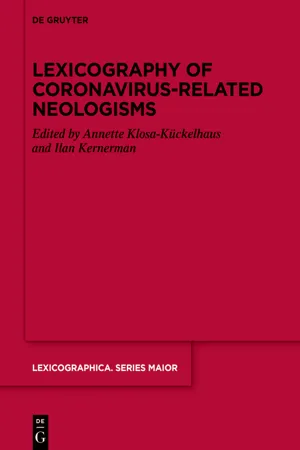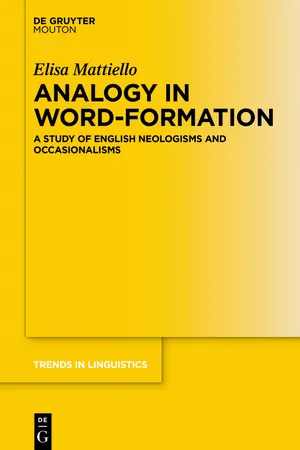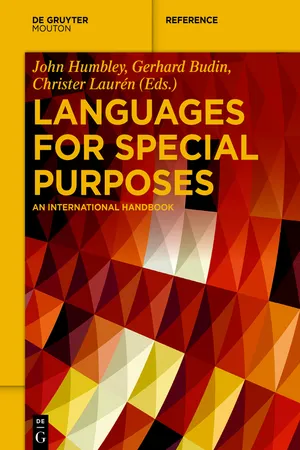Languages & Linguistics
Neologism
A neologism is a newly coined word or expression that has not yet been widely accepted into the mainstream language. Neologisms can be created intentionally or emerge organically, often reflecting changes in society, technology, or culture. They can add richness and flexibility to a language, but their acceptance and longevity can vary.
Written by Perlego with AI-assistance
3 Key excerpts on "Neologism"
- eBook - ePub
- Annette Klosa-Kückelhaus, Ilan Kernerman, Annette Klosa-Kückelhaus, Ilan Kernerman(Authors)
- 2022(Publication Date)
- De Gruyter(Publisher)
Neologisms can, therefore, be analysed according to different perspectives. In line with what has been stated by Lino, “Neologisms are simultaneously a manifestation of the evolution of a language and the evolution of knowledge, both of which happening at an extremely quick pace” (2019 : 10). Terminologists and lexicologists look at the phenomenon of neology from a different standpoint. In terminology science, a Neologism is defined as a “term that is specifically coined for a given general concept” (ISO 1087:2019, §3.4.12), whereas in general language, a Neologism is defined as “a new word” or “a new meaning of an existing word in the language” (Pruvost and Sablayrolles 2003). The difference is quite significant. That is probably the reason why, in terminology science, the terms “neoterm”, “terminological Neologism” (ISO 1087:2019) and “neonymy” (Rondeau 1984) have been created to differentiate the conceptual level from the linguistic one. In lexicology and lexical morphology, Neologisms are mainly studied as part of word formation and semantics, the latter further exploring topics related to semantic shifting or semantic extension. Relevant linguistic phenomena include, among others, the formation of terms, the study of collocations and phraseologies, lexical and semantic relations, formal and semantic neology, as well as variation. In several of these phenomena, the identified linguistic change often has an impact on the dictionary’s macro- and microstructure, as well as on the lexical units to be selected to feed the lexicographic resource. These lexicographic activities require that corpora are consistently maintained and up-to-date to detect Neologisms and neoterms in time to meet the users’ demands. 2.2 Determinologisation processes Determinologisation (Guilbert 1975, Galisson 1978, Meyer and Mackintosh 2000) is the process by which a term is transformed into a general language word or expression - eBook - ePub
- Elisa Mattiello(Author)
- 2017(Publication Date)
- De Gruyter Mouton(Publisher)
per se has diachronic relevance. A word is truly new only at the time when it enters the lexicon of a language. By contrast, when a word is attested in prominent dictionaries for decades and becomes part of the common vocabulary, it is no longer felt as a proper Neologism.In diachrony, new words can be classified into:Past Neologisms: Several new words were introduced into the English lexicon during the Early Modern English period (late fifteenth century‒late seventeenth century), when the greatest vocabulary expansion of English was recorded. Words coming from Latin (e.g. agenda [a 1623], data [1645], †instruct [1529], nucleus [1668], propaganda [1668]) or French (e.g. brigade [a 1649], civilisation [1656], elegant [c 1475], regime [c 1475]) contributed to this expansion (Mazzaferro 2009: 39). However, they represent Neologisms only from a historical viewpoint, in that synchronically they are no longer considered ‘new words’.Recent Neologisms: A great number of novel words have entered the English vocabulary since the last century, especially in the 1980s–1990s, with the advent of new technologies and new media, such as the Internet. They include words like blog [1999] ← web + log (OED3), e-reader [1999] ‘a hand-held electronic device used for reading e-books’ (OED3), netizen [1984] ← net + citizen (OED3), and vapourware [1993], used humorously for ‘a piece of software which, despite being publicized or marketed, does not exist’ (OED2), which have become part of the institutionalised language and are, therefore, codified in dictionaries.Present-day Neologisms/occasionalisms: Newly coined words enrich the English vocabulary every day, with analogy playing a fundamental role in their coinage. Most of them originate from the news, tabloids, TV shows, sit-coms, blogs, social network sites, and other state-of-the-art genres. Some are occasionalisms in the traditional sense, because they have expressly been coined for a single occasion and tend to vanish as rapidly as they have been created. A case in point is the ephemeral verb prooflisten [2000] ‘to listen to a recording of words or music to check for errors’ (after proofread [1845]), which occurred in Christine Webb’s letter of 4th March 2000 in The Guardian , and was later recorded in Wordspy . Other words, instead, seem more stable. The word advertainment [1999], for instance, occurs eleven times in The Guardian complete archive and once in The Independent and in COCA (“They believe disclaimers will ruin the beauty of ‘advertainment ’”, 2004). Therefore, like its attested analogues docutainment [1978] ‘a film or other presentation which includes documentary materials, and seeks both to inform and entertain’ (OED2), infotainment [1980] ‘broadcast material which seeks to inform and entertain simultaneously’ (OED3), and edutainment - eBook - ePub
Languages for Special Purposes
An International Handbook
- John Humbley, Gerhard Budin, Christer Laurén(Authors)
- 2018(Publication Date)
- De Gruyter Mouton(Publisher)
The question of a specific theory for term formation rather than word formation remains open. In practice, terms are generally seen as units expressing specialised concepts, leading to a de facto difference since terminologists classify multi-word units as terms whereas lexicographers tend to regard them as collocations (Wright 1991). But the conceptual basis of terminology is not accepted by many terminologists, especially in Romance language countries, and there the borders between term and word formation tend to be overlooked.References
Alves, Ieda. [1990]2007. Neologismo. Criação lexical . 3rd edn. São Paulo: Ática.Alves, Ieda. 2001. Terminologia e neologia. Tradterm 7. 53–70.Antia, Bassey Edem and Richard Kamai. 2006. African Issues in Terminology: An Educational Perspective. In Heribert Picht (ed.), Modern Approaches to Terminological Theories and Applications , 135–152. Bern: Peter Lang.Becherel, Danièle. 1981. A propos des solutions de remplacement des anglicismes. La Linguistique 17(2). 119–131.Bauer, Laurie. 1983. English word formation . Cambridge: Cambridge University Press.Becker, Holger. 2005. Semantische und lexikalische Aspekte der mathematischen Fachsprache des 19. Jahrhunderts. Oldenburg University thesis available at http://docserver.bis.uni-oldenburg.de/publikationen/dissertation/2006/becsem05/becsem05.html (last accessed 15 April 2018).Beinke, Christiane. 1990. Der Mythos franglais. Zur Frage des Akzeptanz von Angloamerikanismen im zeitgenössischen Französisch – mit einem kurzen Ausblick auf die Anglizismen-Diskussion in Dänemark . (Europäische Hochschuleschriften, Reihe XIII, Französische Sprache und Literatur, Band 151). Frankfurt am Main: Peter Lang.Braun, Peter. 1990. Internationalismen – Gleiche Wortschätze in europäische Sprachen. In Peter Braun, Burkhard Schaeder and Johannes Volmert (eds.), Internationalismen. Studien zur interlingualen Leixikologie unde Lexikographie , 13–33. Tübingen: Niemeyer.Cabré, Maria Teresa. 1992. La terminologia , la teoria, els mètodes, les aplicacions . Barcelona: Editorial Empuries . Translated into Spanish by Carles Tebé as Cabré, Maria Teresa. [1992]1993. La terminología . Teoría, metogología, aplicaciones . Barcelona: Editorial Antártida/Empuries. Translated into English as Cabre, Maria Teresa. [1992]1999. Terminology : Theory, Methods, and Applications
Index pages curate the most relevant extracts from our library of academic textbooks. They’ve been created using an in-house natural language model (NLM), each adding context and meaning to key research topics.
Explore more topic indexes
Explore more topic indexes
1 of 6
Explore more topic indexes
1 of 4


